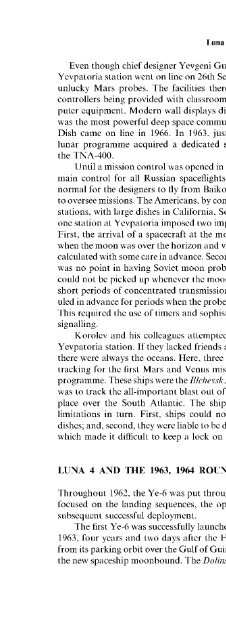Soviet and Russian Lunar Exploration
Soviet and Russian Lunar Exploration
Soviet and Russian Lunar Exploration
Create successful ePaper yourself
Turn your PDF publications into a flip-book with our unique Google optimized e-Paper software.
Luna 4 <strong>and</strong> the 1963, 1964 rounds of launchings 77<br />
Even though chief designer Yevgeni Gubensko died in the middle of construction,<br />
Yevpatoria station went on line on 26th September 1960, just in time for the first, but<br />
unlucky Mars probes. The facilities there were originally quite primitive, ground<br />
controllers being provided with classroom-style desks, surrounded by walls of computer<br />
equipment. Modern wall displays did not come in until the mid-1970s. Still, it<br />
was the most powerful deep space communications system until NASA's Goldstone<br />
Dish came on line in 1966. In 1963, just in time for the new Ye-6 missions, the<br />
lunar programme acquired a dedicated station, a 32 m dish in Simferopol called<br />
the TNA-400.<br />
Until a mission control was opened in Moscow in 1974, Yevpatoria remained the<br />
main control for all <strong>Russian</strong> spaceflights, not just the interplanetary ones. It was<br />
normal for the designers to fly from Baikonour Cosmodrome straight to Yevpatoria<br />
to oversee missions. The Americans, by contrast, had a worldwide network oftracking<br />
stations, with large dishes in California, South Africa <strong>and</strong> Australia. Dependence on<br />
one station at Yevpatoria imposed two important limitations on <strong>Soviet</strong> lunar probes.<br />
First, the arrival of a spacecraft at the moon had to be scheduled for a time of day<br />
when the moon was over the horizon <strong>and</strong> visible in Yevpatoria, so schedules had to be<br />
calculated with some care in advance. Second, as noted during the 1959 missions, there<br />
was no point in having <strong>Soviet</strong> moon probes transmit continuously, for their signals<br />
could not be picked up whenever the moon was out of view. Instead, there would be<br />
short periods of concentrated transmission, called 'communications sessions' scheduled<br />
in advance for periods when the probes would be in line of sight with Yevpatoria.<br />
This required the use of timers <strong>and</strong> sophisticated systems of control, orientation <strong>and</strong><br />
signalling.<br />
Korolev <strong>and</strong> his colleagues attempted to get around the limits imposed by the<br />
Yevpatoria station. If they lacked friends <strong>and</strong> allies abroad to locate tracking dishes,<br />
there were always the oceans. Here, three merchant ships were converted to provide<br />
tracking for the first Mars <strong>and</strong> Venus missions, but they could also serve the moon<br />
programme. These ships were the Illchevsk, Krasnodar <strong>and</strong> Dolinsk <strong>and</strong> their main role<br />
was to track the all-important blast out of parking orbit, which was expected to take<br />
place over the South Atlantic. The ships were a helpful addition, but they had<br />
limitations in turn. First, ships could not carry dishes as large as the l<strong>and</strong>-based<br />
dishes; <strong>and</strong>, second, they were liable to be disrupted in the event of bad weather at sea,<br />
which made it difficult to keep a lock on a spacecraft in a rolling sea.<br />
LUNA 4 AND THE 1963, 1964 ROUNDS OF LAUNCHINGS<br />
Throughout 1962, the Ye-6 was put through a rigorous series of ground tests. These<br />
focused on the l<strong>and</strong>ing sequences, the operation of the airbags <strong>and</strong> ensuring their<br />
subsequent successful deployment.<br />
The first Ye-6 was successfully launched into Earth parking orbit on 4th January<br />
1963, four years <strong>and</strong> two days after the First Cosmic Ship. Block L was due to fire<br />
from its parking orbit over the Gulf of Guinea toward the end of the first orbit to send<br />
the new spaceship moonbound. The Dolinsk was steaming below to track the signals.







